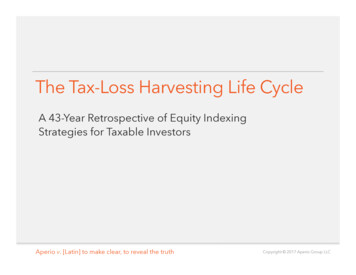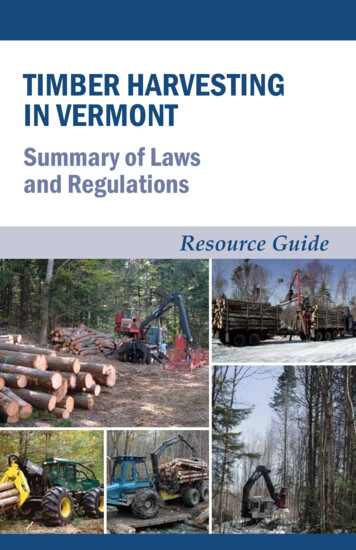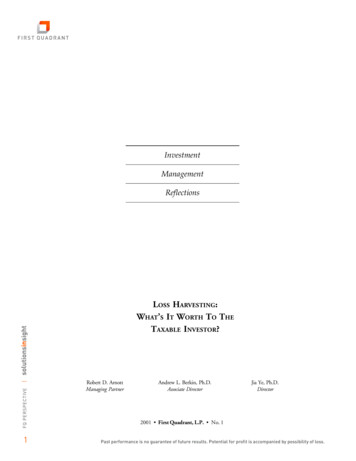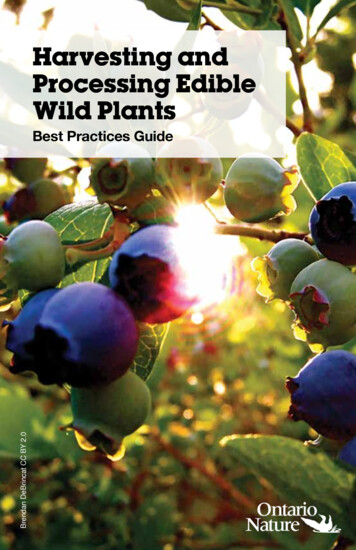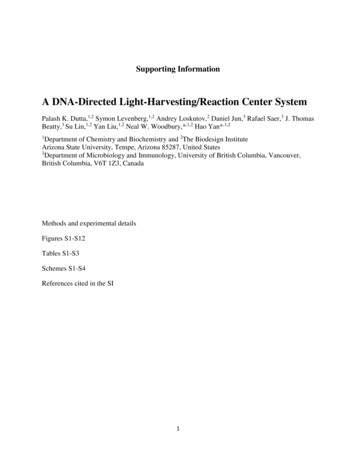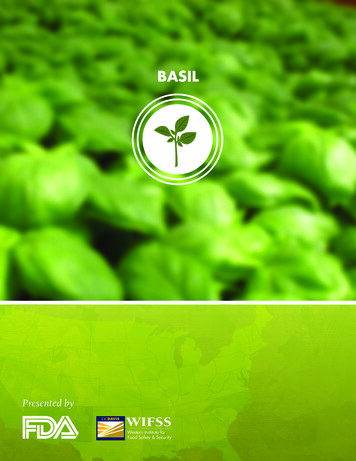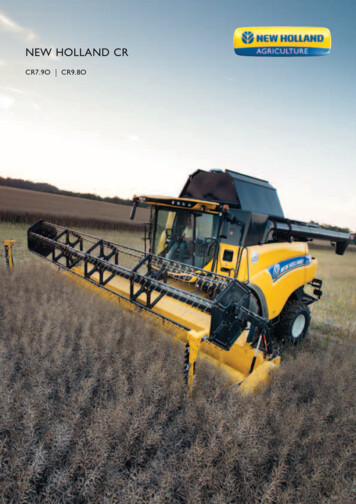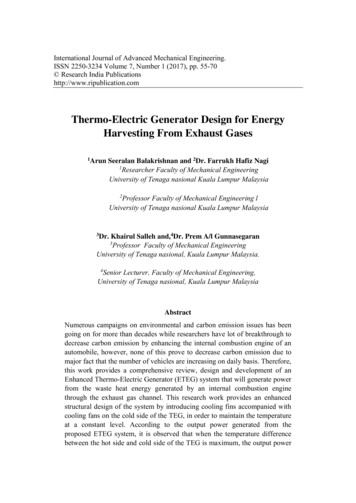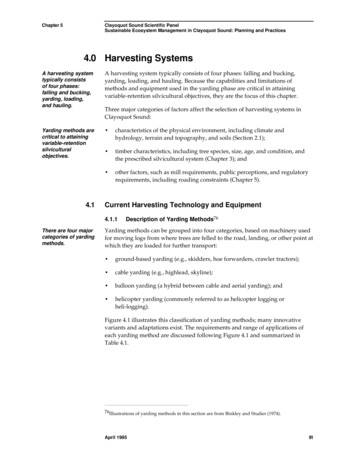
Transcription
Chapter 5Clayoquot Sound Scientific PanelSustainable Ecosystem Management in Clayoquot Sound: Planning and Practices4.0 Harvesting SystemsA harvesting systemtypically consistsof four phases:falling and bucking,yarding, loading,and hauling.A harvesting system typically consists of four phases: falling and bucking,yarding, loading, and hauling. Because the capabilities and limitations ofmethods and equipment used in the yarding phase are critical in attainingvariable-retention silvicultural objectives, they are the focus of this chapter.Yarding methods arecritical to . characteristics of the physical environment, including climate andhydrology, terrain and topography, and soils (Section 2.1); timber characteristics, including tree species, size, age, and condition, andthe prescribed silvicultural system (Chapter 3); and other factors, such as mill requirements, public perceptions, and regulatoryrequirements, including roading constraints (Chapter 5).4.1Three major categories of factors affect the selection of harvesting systems inClayoquot Sound:Current Harvesting Technology and Equipment4.1.1There are four majorcategories of yardingmethods.Description of Yarding Methods76Yarding methods can be grouped into four categories, based on machinery usedfor moving logs from where trees are felled to the road, landing, or other point atwhich they are loaded for further transport: ground-based yarding (e.g., skidders, hoe forwarders, crawler tractors); cable yarding (e.g., highlead, skyline); balloon yarding (a hybrid between cable and aerial yarding); and helicopter yarding (commonly referred to as helicopter logging orheli-logging).Figure 4.1 illustrates this classification of yarding methods; many innovativevariants and adaptations exist. The requirements and range of applications ofeach yarding method are discussed following Figure 4.1 and summarized inTable 4.1.76Illustrations of yarding methods in this section are from Binkley and Studier (1974).April 199591
Chapter 5Clayoquot Sound Scientific PanelSustainable Ecosystem Management in Clayoquot Sound: Planning and PracticesFigure 4.1Classification of yarding methods.yarding icoptertrue skylinelivestandingskylineskyline(slackline) gcraneswing yarder(chokers)Ground-Based YardingIn ground-basedyarding, the machinetravels to the log,then moves it to alanding.Applicability ofground-basedmethods is limited byslope, soil, andweather conditions.In ground-based yarding, the machine travels to the log, then moves it to acollection point (landing). “Skidders” move on tracks or wheels to the logs andskid or drag them, usually with one end raised above the ground, to the landing.“Forwarders” transport logs without dragging them. Rubber-tired(Scandinavian style) forwarders carry relatively short logs in bunks. “Hoeforwarders” (or “hoe chuckers”) use a modified backhoe or hydraulic loader tolift, then swing or slide logs to a yarding or skidding corridor,77 to roadside, orto a landing.Because skidders pull logs, they are constrained by slope and slopeconfiguration, and can cause high soil disturbance. Rubber-tired forwarders aremore constrained by slope than skidders. Hoe forwarders remain stationary asthey swing logs and can operate on steeper slopes (up to 30–35%) with lowerpotential for soil disturbance. While both skidders and forwarders aresufficiently manoeuvrable to remove logs from the site with limited damage toresidual standing timber, their potential to damage tree roots and soil duringyarding must be considered.Ground-based methods, especially skidders, are weather sensitive. Duringheavy or prolonged rain their operation may be suspended because the soil losesstrength, resulting in increased potential for soil and/or root damage.77Yarding corridors (also called yarding “roads”) refer to the roughly linear paths that logs travel asthey are pulled by cables (lines) from the location of felling and bucking to the landing, or other areawhere logs are collected for loading. Skidding corridors are analogous but refer to designated routesused by ground-based equipment.April 199592
Chapter 5Clayoquot Sound Scientific PanelSustainable Ecosystem Management in Clayoquot Sound: Planning and PracticesCable YardingCable yarding methods are characterized by stationary yarders which move logsby cables from where the trees were felled, along yarding corridors to a landingor to roadside. The amount of soil disturbance from cable yarding is a function ofthe extent to which logs remain in contact with the ground as they travel fromthe cutblock to the landing. This extent of contact ranges from full suspension topartial suspension to ground lead. 78Two basic types of cable yarding can be differentiated: highlead and skyline.HighleadThe highlead method, where chokers are attached directly to the mainline, canprovide no more than partial suspension of logs as a consequence of tower heightand topography (Figure 4.2). The method has no lateral yarding capability79beyond the length of the chokers.Highlead yarding hasno lateral yardingcapability beyond thelength of thechokers.Highlead yarding is usually limited to yarding distances of 200–300 m(dependent on log lift 80). Log lift, log control, and production rate decreaserapidly with increased yarding distance. Typical production values range from alow of 100 m 3/shift for poor lift and long distances, to about 220 m3/shift forshort distances and good lift. 81 Highlead systems usually require a crew of fiveto six people. Highlead towers access fan-shaped to roughly circular areas withyarding corridors radiating out from a central landing (Figure 4.3).78With “full suspension,” logs are suspended in the air as they travel from where they are hooked up(in the cutblock) to the landing. With “partial suspension,“ one end of the log is in contact with theground while the logs are yarded (dragged) to the landing. With “ground lead,” little or no liftingforce is applied where the chokers attach to the logs; there is insufficient clearance between theground and the loaded cable path to lift the end of the logs off the ground. Logs then commonly hangup behind stumps, and ground disturbance can be severe.79Lateral yarding (also referred to as lateral reach or lateral reach capability) refers to the ability toyard logs from the stand into a main yarding corridor.80Lift refers to the lifting force applied to a log by a cable yarding system. Lift varies continuouslyalong the path travelled by the yarded log.81Production figures (m 3 of logs yarded to a landing) are for a regular 8-hour shift less travel time.April 199593
Chapter 5Clayoquot Sound Scientific PanelSustainable Ecosystem Management in Clayoquot Sound: Planning and PracticesFigure 4.2Highlead yarding with chokers attached to the mainline via buttrigging.Figure 4.3Yarding corridor patterns: radiating versus parallel.central landingsroadCentral landings require a largedecking area or a dedicated log loaderto prevent excessive congestion in thelanding. Typical for highlead or ationroadparallel yarding corridorsApril 1995Parallel (to sub-parallel) yardingcorridors allow logs to be deckedalong the road. The corridororientation varies somewhat inresponse to concave and convexslope forms. Yarding and loadingphases can be undertaken at differenttimes. Typical for yarding cranes.94
Chapter 5Clayoquot Sound Scientific PanelSustainable Ecosystem Management in Clayoquot Sound: Planning and PracticesSkylineSkyline yarding can be divided into “true” skylines and running skylines. Trueskylines include both live skyline (slackline) and standing skyline. Runningskylines, like highlead, have two main operating lines: a mainline and a haulbackline. However, in a running skyline configuration, the haulback doubles as askyline to support a carriage or log grapple thus providing additional log lift.The configuration and movement of the cable and carriage define the type ofskyline (Figures 4.5, 4.6, and 4.7).Skyline systems canyard up to 1000 mor more, givenappropriatetopography.Skyline systems can use a relatively short crane (15–17 m) built on an excavatorlike undercarriage (called a yarding crane or swing yarder) or a 27–30 m steeltower (called tower skyline). Either machine can yard up to 1000 m or more,given appropriate topography. Yarding cranes, which were developed in the1960s, are very mobile, require two to four guylines, and can rotate withoutaffecting these lines. By comparison, tower skylines require six to eight guylines,are stationary, require a larger crew to operate, and take more time to move.However, the taller towers have two advantages over yarding cranes: theypermit higher log payloads and make yarding possible in broken terrain or otherdifficult topography.April 199595
Chapter 5Clayoquot Sound Scientific PanelSustainable Ecosystem Management in Clayoquot Sound: Planning and PracticesAttaching chokersto a dropline orskidding line allowsfor lateral yarding.Carriages are available in a range of types and sizes; they can be mechanicallyoperated from the yarder or radio-controlled by the yarder and rigging crews.The carriage determines the ability of the skyline to yard logs laterally from theadjacent forest as well as from within the yarding corridor. Simple carriages withchokers directly attached, an uncommon configuration now, do not have lateralyarding capability. Carriages with chokers attached to a dropline82 or skiddingline, which can itself be pulled out (Figure 4.4), have lateral yarding capabilitiestypically ranging up to 30 m. Both tower skylines and cable cranes can use thesecarriages.Figure 4.4Grapple yarding isbest suited toclearcuts with shortyarding distanceswhere roads are notconstrained.Simple carriages with and without lateral yarding capability.A running skyline can operate either with chokers or with a log grapple. Thegrapple yarder is a configuration of running skyline that uses a relatively shortyarding crane (swing yarder) equipped with a log grapple (rather than chokers)to grasp and yard logs (Figure 4.5). 83 The grapple yarder has no lateral yardingcapability. Grapple yarding corridors are parallel and narrowly spaced; logs arelanded at the roadside, or on the road where slopes exceed about 45%. Byincrementally moving the yarding equipment along the road, yarding corridorscan be kept nearly perpendicular to the road and slope contours. Where a mobilebackspar machine (e.g., a modified hydraulic excavator) is used to speedmovement between corridors and to increase lift, backspar trails are required.Grapple yarders are normally used to yard logs across distances of less than150–200 m. Grapple yarding is best suited to clearcuts with short yardingdistances where roads are not constrained.82A dropline is a skidding line that can be pulled out (dropped) from below the carriage to extendthe lateral reach of the chokers. The dropline can be an extension of the mainline (Figure 4.4) or bewound on the drum in the carriage (Figure 4.6).83Grapple yarding refers to a cable-based method of yarding logs with a grapple (or grapple tongs)from where they are felled and bucked, to a roadside. This method employs a yarder with a 15- to17-m crane built on a hydraulic excavator-like chassis. In British Columbia coastal operations, thechassis is commonly on tracks.April 199596
Chapter 5Clayoquot Sound Scientific PanelSustainable Ecosystem Management in Clayoquot Sound: Planning and PracticesFigure 4.5Grapple yarder.When a running skyline is configured for chokers rather than a grapple, alightweight carriage can be used (Figure 4.6). Depending on the type andcapabilities of the carriage, lateral yarding of up to 30 m is feasible. This allowsfor retention cuts, where some or all of the retained trees are dispersedthroughout the cutting unit.With true skyline yarding, both live and standing skylines use a stationary cable(“skyline”) suspended between a yarding tower and a backspar. The mainlineattaches to a carriage that travels along the skyline by gravity or by controllingmainline and haulback movement at the yarder.April 199597
Chapter 5Clayoquot Sound Scientific PanelSustainable Ecosystem Management in Clayoquot Sound: Planning and PracticesFigure 4.6Live skyline with a radio-controlled slackpulling carriage showingfull log suspension.Photo 4.1In this example, a live skyline with a tower is beingused to yard logs over a forested riparian corridor.April 199598
Chapter 5Clayoquot Sound Scientific PanelSustainable Ecosystem Management in Clayoquot Sound: Planning and PracticesLive skylines aretypically used whereroad access isconstrained and longyarding distances(greater than 300 m)are required.The “live skyline” is suspended between the yarder and a backspar (usually atree), with one end of the cable anchored to tail-holds and the other wound on adrum so that the skyline can be lowered and raised during yarding (Figure 4.6).A carriage rides on the skyline with chokers attached directly to the carriage orto a dropline. In the latter case, chokers can be pulled laterally into the stand.Logs are commonly yarded with partial suspension, although full suspension ispossible in suitable topography. Live skylines are typically used where roadaccess is constrained and long yarding distances (greater than 300 m) arerequired.Standing skylinesare used where fullsuspension of logsis desired or foryarding longdistances—of up to 1500 m.In the “standing skyline,” both ends of the skyline cable are secured and theskyline cannot be raised or lowered during yarding (Figure 4.7). Chokers areattached to a dropline which can be lowered to the ground; logs are attached andpulled up to the carriage. Standing skylines are used where full suspension oflogs is desired (e.g., to move logs from one side of a stream to the other, whereroads are not possible or permitted, or for yarding long distances—up to1500 m). With appropriate topography the system can carry logs over standingtrees or regeneration; otherwise, narrow yarding corridors must be cut throughstanding timber. Multi-span configurations are sometimes feasible with standingskylines. 84Figure 4.7Standing skyline with a radio-controlled carriage.84Multi-span configurations involve two or more spans of the skyline by using intermediatesupports.April 199599
Chapter 5Clayoquot Sound Scientific PanelSustainable Ecosystem Management in Clayoquot Sound: Planning and PracticesBalloon YardingBalloon yarding overcomes some of the limitations of cable systems (e.g., yardingdistance, payload, and lift) in unfavourable topography. Balloon yarding usescables to move logs to a stationary yarder at the landing, in much the same wayas traditional cable systems. However, lift is provided by the balloon rather thanas a consequence of topography and tower height.Balloons areinappropriate forretention silviculturalsystems.Balloons can yard up to 1500 m, thus reducing road access requirements. Theirvertical lift capability (15 000–18 000 kg) enables full suspension of logs. Balloonsare best suited to larger clearcut operations because of the high log volumesneeded to offset high set-up costs. Balloons are inappropriate for retentionsilvicultural systems because imprecise manoeuvring and positioning of theballoon reduces control of the operating lines (cables).Helicopter YardingHelicopters aretypically used toyard logs in sensitiveor otherwiseinaccessible terrain.Helicopters are typically used to yard logs in sensitive or otherwise inaccessibleterrain. Optimal flight distance is typically 600–1000 m although maximumyarding distances can extend to 2000 m, with high value timber. Level todownhill flight paths are preferred to take advantage of gravity. Widenedroadsides or water, rather than constructed landings, can be used as unloadingsites (drop sites) for logs.Compared to ground-based and cable yarding methods, helicopter logging hasboth higher operating costs ( 45–60/m3) and higher yarding production rates(500–1500 m 3/shift). Because of high production rates, safe, efficient movementof workers and equipment requires careful planning. If central landings are used,they must be relatively large to accommodate log storage and segregate workactivities for adequate worker safety. For such reasons, pre-harvest planning andorganization are critical to the success of helicopter logging operations. Becausehelicopters have specific, limited payload lifting capacity,85 and very highoperating costs, logs—especially large logs—must be bucked precisely so thathelicopters carry near to maximum payload and log value on each trip.Helicopters with heavy-lift payload capacity (e.g., Sikorsky S-64 and BoeingVertol) are more suitable for higher levels of retention than medium-lift machines(e.g., Sikorsky S-61), because of their greater ability to lift logs almost verticallythrough remaining forest canopy.Helicopter yarding is more sensitive to weather than cable yarding. Winds andlanding location need to be considered. Fog, low cloud, and wind speeds above50 km/hr usually suspend helicopter operations.85“Payload lifting capacity” refers to the weight that a helicopter can safely lift and transport.Helicopters can be classified as “low-lift” (up to 5000 lbs), “medium-lift” (5000–10 000 lbs), and“heavy-lift” (greater than 10 000 lbs).April 1995100
Chapter 5Clayoquot Sound Scientific PanelSustainable Ecosystem Management in Clayoquot Sound: Planning and PracticesTable 4.1 summarizes the basic characteristics and capabilities of each yardingmethod.Table 4.1YardingmethodGround basedSkidders(rubber-tired ortracked)Hoe forwarderYardingdistanceLimiting slope Applicability to%differentsilviculturalsystemsUphill 120 m;downhill and flat60–600 m30–40%Uphill 20–70 m;downhill20–120 mScandinavian - 150–600 mstyle forwardersCableCharacteristics of common yarding methods.YardingcorridorarrangementPotential fordetrimentalsoildisturbanceCommentsModerateto highBest suited to drier and/orcold climates, and strongsoils (coarse-textured, dry,or frozen); potential for rootdamageUphill 15–30%; Flexible; clearcuts, Flexibledownhill 35% partial and retentioncuts, and thinningLow ( 5%) ifmeasurestaken toprotect soilsAllows full separation ofyarding and loading; lowlabour requirement15–20 %Low tomoderatePotential for future use inmanaged stand harvestLow tomoderate,depends onlift; locally highin ground-leadsituations or inbroken orgullied terrainLift is limited by tower heightand slope configuration;partial suspension infavourable topographyLow withadequate logsuspension15–17 m crane; uses roadas landing; mobile backsparimproves efficiency; only2–4 guylines; fast yardingcorridor changesFlexible; clearcuts, Flexiblepartial and retentioncutsFlexible; clearcuts,retention cuts,thinningFlexibleHighleadUphillDetermined by100–300 m;falling anddownhillbucking safety30–100 m(recommended),30–200 m(typical); nolateral yardingGrapple yarderUphill100–200 m;downhill50–150 m;no lateralyardingDetermined by Most effective forfalling andclearcuts or stripbucking safety cuts due to lack oflateral yardingcapabilityYarding crane(swing yarder)with droplinecarriageUphill100–700 m;downhill100–400 m;10–30 m lateralyardingDetermined by Flexible; clearcuts, Parallel; at rightfalling andpartial and retention angle or angledbucking safety cutsto road; andradiatingLow withadequatesuspension15–17 m crane; uses roadas landing; mobile backsparimproves efficiency; only2–4 guylines, fast yardingcorridor changesLive skyline(tower)Uphill,up to 1000 m;downhill, up to700 m; lateralyarding to 30 mDetermined by Flexible; clearcuts, Radiatingfalling andpartial and retentionbucking safety cuts, thinningMinimal withadequatesuspension6–8 guylines; accesses largearea, may stay in place forone to several weeks; largevolume accumulates at thelanding; requires soundanchors for guylines and tailholds; usually for single-spanoperationsStandingskyline (tower)Uphill or downhill Determined by Flexible; clearcuts, Radiatingup to 1500 m;falling andpartial and retentionlateral yarding to bucking safety cuts, thinning30–60 mMinimal;full suspensionsystem insuitabletopographyUsed where full suspensionis required (e.g., moving logsover a stream); requiressound anchors for guylinesand tail-holds; has multispan potentialBalloonUp to 1500 mDetermined by Limited to largefalling andclearcuts due tobucking safety lack of line controlRadiatingMinimal;Requires large volumes tofull suspension be economical; verysystemsensitive to wind /heavy rainHelicopterUp to 2000 mwhere timbervalue allowsDetermined by Very flexible;falling andclearcuts,bucking safety partial, andretention cutsNo corridorsNoneApril 1995Clearcuts, apartRadiatingfrom strips orwedges in the outerhalf of settingParallel; at rightangle or slightlyangled to road(downhillyarding)Road as landing or waterdrop; snags and otherdanger trees must beremoved above and aroundhook-up areas; highoperating costs; must run atnear capacity; weathersensitive101
Chapter 5Clayoquot Sound Scientific PanelSustainable Ecosystem Management in Clayoquot Sound: Planning and Practices4.1.2Factors Affecting Choice of Harvesting SystemAs previously noted, harvesting systems are selected based on site variables andmanagement objectives. Specific factors affecting the choice of harvesting systeminclude: topography (slope steepness and variability); soil (composition, sensitivity to disturbance); silvicultural system (level of retention, number of harvest entries); timber characteristics (log size and volume per hectare); potential road access and roading constraints (Chapter 5); and yarding distance and direction; if cable yarding, desired log suspension (fullor partial) is based on risk of detrimental soil disturbance, damage toretained trees, and protection of other resource values.The selection of harvesting system follows a decision matrix (Figure 4.8).Topography and soilcharacteristics arethe key factors indetermining ifground-basedyarding methodsare appropriate.Topography and soil characteristics are the key factors in determining if groundbased yarding methods are appropriate. Ground-based yarding equipment islimited to slopes of less than about 35%, and is further constrained by soil typein relation to weather (i.e., rain, soil water content, soil-bearing strength).Yarding distance anddirection also affectharvesting options.Yarding distance and direction also affect harvesting options. Tower skylineyarding requires central landings with radiating yarding corridors. Thesecorridors tend to accumulate large volumes of timber in the landing and,because of corridor overlap close to the landing (Figure 4.3), cannot retain treesnear the landing. Radiating corridors may also require cross-slope yarding withattendant difficulty in controlling logs, and consequent potential for increasedground disturbance and damage to the residual stand. In such situations, fullsuspension may be required to keep corridor width, ground disturbance, andresidual tree damage within acceptable levels (Figure 4.9).For all yarding methods, stand and timber characteristics, such as volume perhectare and log size, influence choice of machine size and power, productionrates, and operating costs. In general, an inverse relationship exists betweenharvest unit costs ( /m3), and log size and timber volume per hectare. Indirectcosts such as minimizing damage to soil or aesthetic values also influenceprofitability of harvesting operations. Capital, operating, and labour costs aresignificantly higher for cable yarding and heli-logging than for ground-basedsystems. The feasibility of locating and constructing roads determines how closeyarding equipment can get to the timber and may be an overriding determinant.April 1995102
Chapter 5Clayoquot Sound Scientific PanelSustainable Ecosystem Management in Clayoquot Sound: Planning and PracticesFigure 4.8Harvesting systems decision matrix.topography?(slope) 30–35% 30–35%ground–basedyarding possibleno ground–based earcutall cablehelicopteror edispersedaggregatedhelicoptersoilsensitivity?some cablelateral reach oftennot necessaryradiating yardingpattern possiblehelicoptersome cablelateral reachrequiredparallel yardingpattern usuallyrequiredSummarysilviculturalsystemslope hodlow soilsensitivitymedium soilsensitivityhigh soilsensitivityskidderhoeforwarderavoid groundbased yardingvariable-retentionpossibleslope 30–35%clearcutall riable-retention systemaggregated retentiondispersed retentionsome cablesome cablelateral reach oftennot necessaryradiating yardingpattern possiblelateral reachrequiredparallel yardingpattern usuallyrequiredhelicopterhelicopterApril 1995103
Chapter 5Clayoquot Sound Scientific PanelSustainable Ecosystem Management in Clayoquot Sound: Planning and PracticesHighlead and grappleyarding are bestsuited to clearcuttingwhere logs do notneed to manoeuvrearound standingtrees.In thinning and partial cuttings, including retention, the degree to which logscan be controlled during yarding affects residual tree damage, grounddisturbance, and yarding productivity. Silvicultural systems that retain asignificant number of trees will favour yarding methods with partial or fullsuspension and lateral yarding capabilities. Highlead and grapple yarding arebest suited to clearcutting where logs do not need to be manoeuvred aroundstanding trees, and lateral yarding is unnecessary. Running or live skylinemethods using yarding cranes with dropline carriages are suited to retentioncuts on steep slopes if yarding distances are less than 250–300 m. For longeryarding distances, tower skylines (standing or live) or helicopters arepossibilities.Figure 4.9The effect of log suspension on corridor width whencross-slope yarding.The final considerations in selecting a harvesting system are operational, such asspecific features of timber and terrain, accessibility, and costs.4.2Harvesting in Clayoquot Sound4.2.1Early logging inClayoquot Soundconcentrated on thegentle to moderatetopography.Historical OverviewEarly logging in Clayoquot Sound generally concentrated on the gentle tomoderate topography of the Estevan Coastal Plain near Ucluelet and Tofino, andon steeper slopes close to tidewater.Past harvesting activity in Clayoquot Sound was shaped by an even-agedmanagement regime (clearcutting) and the operating constraints of the westcoast environment (steep slopes, high precipitation, and sensitive soils). Likemuch of British Columbia’s west coast, a clearcutting silvicultural system basedon large old trees favoured handfelling and bucking, and highlead yarding to aApril 1995104
Chapter 5Clayoquot Sound Scientific PanelSustainable Ecosystem Management in Clayoquot Sound: Planning and Practicescentral tower and landing. This changed with the advent of grapple yarding inthe late 1970s.Rising wages in B.C.encouraged a moveto mechanizedyarding operationsas a means ofreducing costs.In the mid- to late 1970s, rising wages in British Columbia encouraged a move tomechanized yarding operations as a means of reducing costs. Highlead yardingoperations, with crew sizes of five to six, were increasingly replaced by grappleyarding operations which required a crew of only two to three people. In 1985,about 90% of the 165 highlead towers operating in coastal British Columbia were11 years or older; few new highlead machines were being purchased (twohighlead towers in two years). By comparison, about two-thirds of the 125operating running skylines were less than 11 years old (Sauder 1988). Yardingcranes, most of which were being used as grapple yarders, had become themachine of choice.Past logging in Clayoquot Sound can be summarized as follows:The popularity ofgrapple yarding inthe 1980s resultedin a denser roadnetwork. The most readily accessible higher-value timber was harvested first. Thecurrent merchantable timber distribution is skewed to more difficulttopography and more sensitive terrain. Immature timber is found on moremoderate topography at lower elevations. Harvesting systems were designed for the prevailing silvicultural system—clearcutting. The popularity of grapple yarding in the 1980s resulted in a denser roadnetwork in the logged portion of the landscape. The bare cutslopes andfillslopes associated with these and earlier roads, plus any subsequent roadrelated slides, increased the visual impact of clearcuts, reduced forestproductivity, and damaged aquatic ecosystems. Prior to the advent of grapple yarding, cutblocks typically involved multiplehighlead settings. This, in combination with little control on cutblockadjacency, except for a short period of logging guidelines in the early to mid1970s (Coast Logging Guidelines 1972), produced large clearcut landscapes.Many of the cutblocks deferred (left unlogged, between logged blocks) underthe 1972 guidelines were logged when rules were relaxed in response to theeconomic recession of the early 1980s. At this time, a short-lived operationusing a standing skyline (European Wyssen system) was employed to avoidroads on steep slopes; it produced a very large, highly visible clearcutopening.The rate of harvesting, and policies regulating cutblock size, shape, and sequencehave changed recently (Section 3.2.2). In the 1980s, more than 1000 ha was loggedannually in Clayoquot Sound; by the early 1990s this had declined to less than600 ha.The Clayoquot Sound Land Use Decision (April 1993), identified 117 400 ha (45%) ofClayoquot Sound for general inte
skyline to support a carriage or log grapple thus providing additional log lift. The configuration and movement of the cable and carriage define the type of skyline (Figures 4.5, 4.6, and 4.7). Skyline systems can yard up to 1000 m or more, given appropriate topography. Skyline systems can use a relatively short crane (15-17Êm) built on an .
